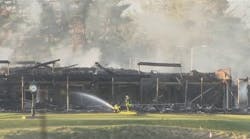March 28--Colorado Springs is the first community to demonstrate how a U.S. Forest Service program for wildfire mitigation can have a drastic impact when it comes to saving homes, according to study released by Fire Adapated Communities last week.
Fire Adapted Communities (FAC), a Forest Service program created 2009, promotes wildfire mitigation in places like Colorado Springs, where a quarter of the city's population lives in the red zone -- an extreme wildfire danger area. The program is a partnership of communities with Firewise programs, all targeted towards wildfire mitigation. The city adoptedFirewise in 2000.
The Waldo Canyon fire last summer gave the forest service and other officials with FAC a first glimpse of how long-established mitigation protects a neighborhood hit by wildfire.
In Colorado Springs, with the help of mitigation, firefighters were able to save homes 82 percent of the time the report concluded.
The statistics get grim when fire hits home.
Around 90 percent of homes ignited by fire were ultimately destroyed, the report also said.
The goal then, is to prevent ignition by using fire-resistant building materials and cutting down combustible vegetation, like Gambel oak or Juniper trees, near homes.
The report is one among many examinations of the Waldo Canyon fire released since it broke out on June 23. The city of Colorado Springs will release its After Action Review, likely one of the most-anticipated reports, next week, although a specific release date has not been set. The review will include police, fire, and city administration overviews of the fire. The city's part will not be an "investigation," but rather a detailed action plan, said Cindy Aubrey, the city's chief communications officer.
The Fire Adapted Communities report offered an outsider's view of the blaze.
Fire Marshal Brett Lacey, of the Colorado Springs Fire Department, oversees two full-time employees in his Wildfire Mitigation section, and works with a $300,000 budget mostly supplemented by national grants and private donations, according to the report. Although it has to make due with relatively little funding, the Mitigation crew has "a strong community education effort" and has been implementing key wildfire-prevention building codes since 1993, The report focused on 38 homes of the 1,525 endangered by the fire. Case studies were done of 26 gutted Mountain Shadows homes, out of at least 346, that were destroyed by the fire.
The report examined notorious conflagration spots in Mountain Shadows, Majestic Drive and Courtney Drive, as well as homes in Cedar Heights, which has been praised for its neighborhood-based fire mitigation work.
Residents have known for months how the fire hit the Mountain Shadows neighborhood. The report offered little that hasn't been said.
Majestic Drive, in Parkside, showed how wildfire spreads from home-to-home. The community of 178 homes in Parkside was nearly obliterated, making it impossible to tell what set off the first spark. But whether the tightly-packed, wood-sided homes were first ignited by embers or by other homes is unimportant -- once one home went up, the radiant heat and embers it emitted quickly ignited its neighbors, the report said.
New building codes for the hillside overlay, which includes Mountain Shadows, mandate fire-resistant siding and deck materials. But for places like Parkside, where a few homes are often less than six feet apart, the report recommended internal fire-resistant materials. Saddletree homes, a local contractor, is using fire retardant lumber to rebuild a Linger Way home, noticeable for its distinctive hot-pink frame.
The report found the fire on Courtney Drive began with a burning storage shed that then spread fire to the majority of the homes on the street. The homes on Courtney were closely spaced as well, and researchers found that radiant heat caused window-frame paint to bubble and shattered some windows. For nearly all neighborhoods, the report recommends double-paned windows or windows with tempered glass, which the new city fire code does not require.
Although the report commended the efforts of homeowners and neighborhoods to rid their areas of excessive Gambel oak and diminish other fuels, it cautioned that the wildfire risk has not been eliminated. Some homes in Mountain Shadows, which survived the fire, still have cedar-shake roofs, outlawed by the city for new construction in 2003.
"Wildfires will continue to occur and homes and communities in wildfire prone areas must be prepared to resist the associated wildfire exposures," the report said.
--
Contact Ryan Maye Handy: 636-0261
Twitter @ryanmhandy
Copyright 2013 - The Gazette (Colorado Springs, Colo.)





